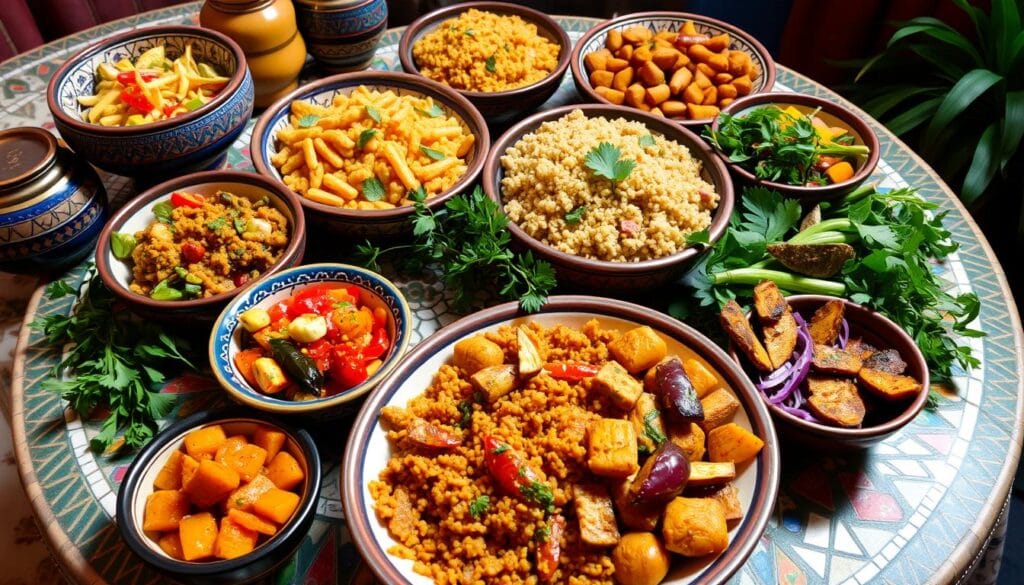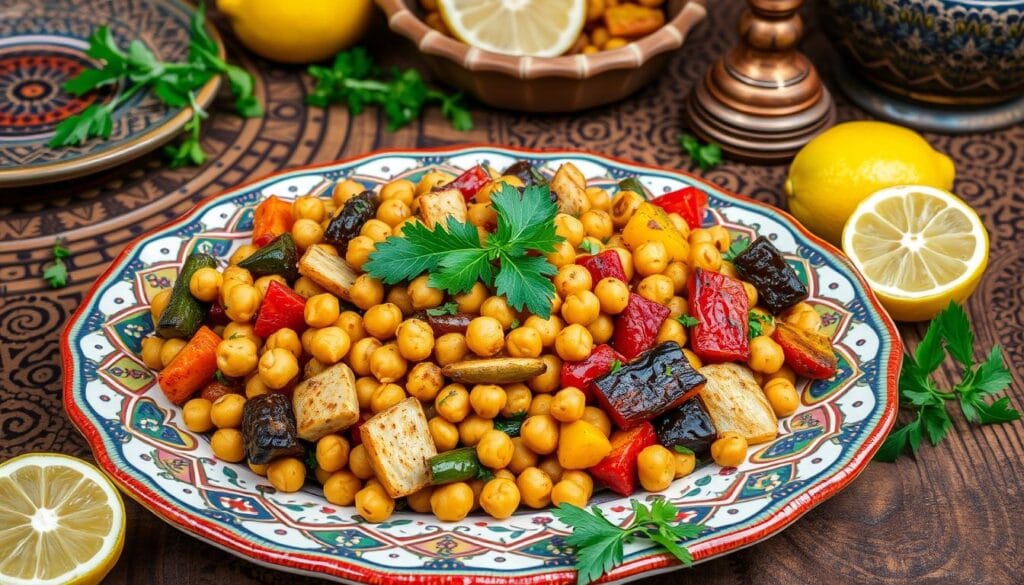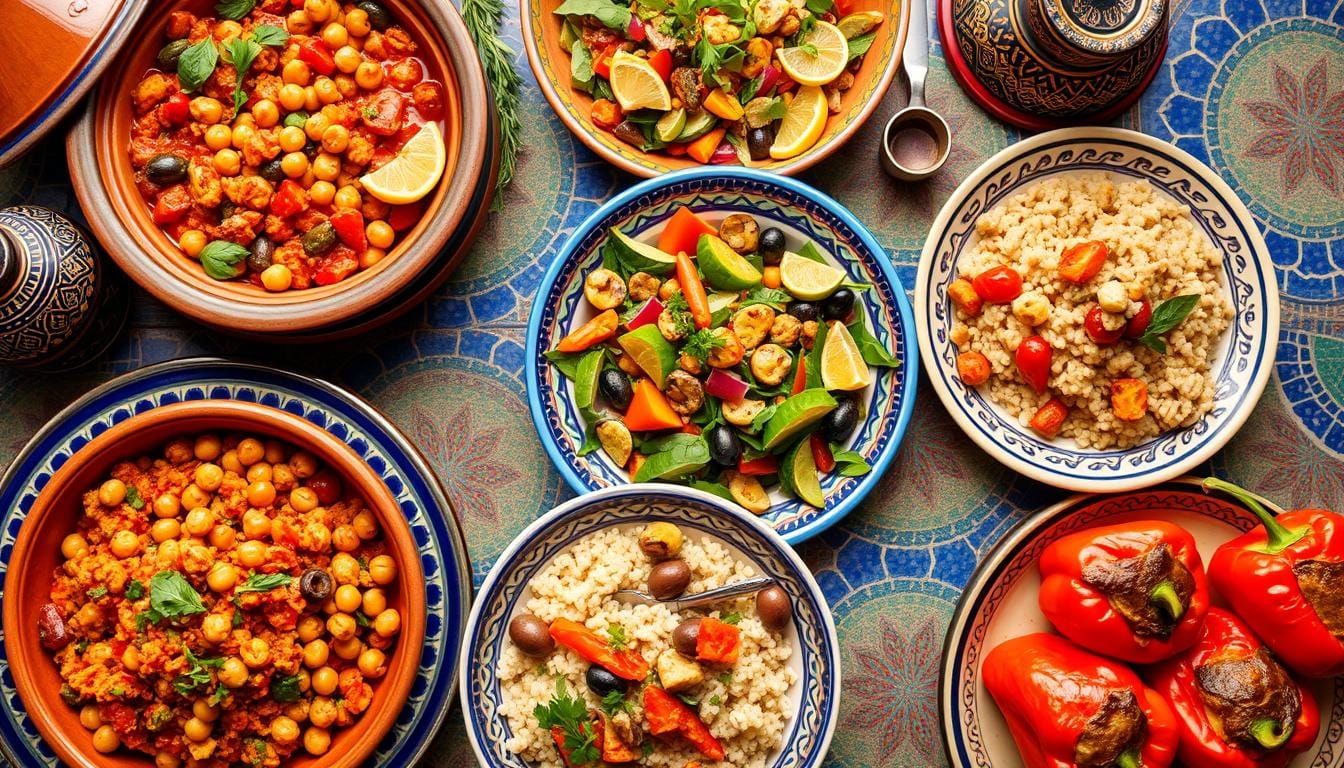Dive into the world of Moroccan cuisine with these tasty vegetarian dishes. Moroccan cooking is a mix of Arab, Berber, Mediterranean, Andalusian, and European flavors. It offers a unique culinary adventure.
From fragrant tagines to rich soups and colorful salads, Moroccan vegetarian dishes are a feast for the senses. They show how spices, fresh ingredients, and old techniques come together. This creates a perfect balance of flavors.
Moroccan vegetarian dishes celebrate the country’s rich culture and fresh produce. You’ll discover the magic of ingredients like couscous, chickpeas, preserved lemons, and the famous ras el hanout spice blend. This journey will take you deep into Moroccan food culture.
Introduction to Moroccan Cuisine’s Vegetarian Heritage
Moroccan cuisine is a colorful mix of flavors, showing the country’s varied cultural roots. It’s known for its Moroccan spices and Mediterranean influence in vegetarian dishes. This North African tradition offers many tasty plant-based options to try.
Understanding Traditional Moroccan Spices and Ingredients
Moroccan vegetarian food centers around a blend of spices like cumin, cinnamon, saffron, and harissa. These spices create a perfect mix of tastes in every dish. The food also includes fresh veggies, legumes, and grains like tomatoes, eggplants, lentils, and couscous.
The Mediterranean Influence on Moroccan Vegetarian Cooking
Moroccan vegetarian dishes also take cues from the Mediterranean region. They use olive oil, olives, and herbs like parsley and cilantro. This mix of North African and Mediterranean tastes makes for a unique and exciting culinary adventure.
Essential Kitchen Tools for Moroccan Cooking
To master Moroccan vegetarian cooking, you need the right Moroccan cooking tools. The tagine pot, with its cone-shaped lid, is key for slow-cooked stews. You’ll also need a couscous steamer and a mortar and pestle for grinding spices.
Moroccan vegetarian cuisine celebrates the land’s abundance, blending cultures and ingredient respect. By knowing the spices, cooking methods, and tools, you can start a flavorful journey through this rich culinary heritage.
Essential Moroccan Vegetarian Dishes for Beginners
Exploring Moroccan cuisine is exciting and rewarding, especially for vegetarian cooks. You’ll love dishes like zaalouk (eggplant and tomato dip) and vegetable tagine. These beginner-friendly moroccan dishes highlight the cuisine’s focus on vegetables, legumes, and spices.
Couscous is key in Moroccan vegetarian cooking. It’s a great base for many meals. Try it with a vegetable tagine, filled with seasonal produce and Moroccan spices.
The traditional harira is a must-try. It’s a hearty soup made with lentils and chickpeas. It’s full of protein and perfect for a cold day.
No moroccan vegetarian recipes list is complete without zaalouk. This eggplant and tomato dip is great as a starter or with m’smen, Moroccan flatbread.
| Dish | Total Time | Servings | Calories per Serving |
|---|---|---|---|
| Vegetable Tagine | 45 minutes | 5-6 | 372 kcal |
| Harira (Lentil and Chickpea Soup) | 1.5-2 hours | 6-8 | 346 kcal |
| Zaalouk (Eggplant and Tomato Dip) | 45 minutes | 6 | 259 kcal |
These beginner-friendly moroccan dishes are just the start of your Moroccan vegetarian journey. They offer a unique mix of spices, vegetables, and legumes. They’re sure to impress your taste buds and satisfy your hunger.
“Moroccan cuisine is a harmonious blend of Mediterranean, Arab, and African influences, resulting in a truly unique and captivating culinary experience.”
Mastering the Art of Vegetable Tagine
Vegetable tagines are a key part of Moroccan vegetarian food. They show off the area’s fresh flavors and textures. To make a great vegetable tagine, you need to know the cooking steps and the right ingredients.
Choosing the Right Vegetables for Your Tagine
Choosing the right vegetables is key to a good tagine. Use a mix of root veggies like carrots, potatoes, and turnips. Add squash and legumes like chickpeas or lentils for flavor and texture. Berbers, 40% of Morocco’s people, use these in their tagines.
Step-by-Step Cooking Process
To make a great vegetable tagine, layer the ingredients. Start with firmer veggies like carrots and potatoes at the bottom. Then add softer ones like zucchini and bell peppers. Add spices like cumin, coriander, and turmeric last. Slow-cooking lets the flavors mix and the veggies get tender.
Serving and Presentation Tips
To finish the Moroccan meal, serve with couscous or Moroccan bread. Top with fresh herbs and a squeeze of lemon. The tagine’s stew-like texture goes well with these, making a complete meal.
Learning to make vegetable tagine brings Morocco’s markets and kitchens to your home. Try different veggies and spices to make it your own.
Moroccan Couscous: The Perfect Vegetarian Base
Couscous is a staple in North Africa, perfect for vegetarian dishes. It’s made from semolina and is quick to cook. This makes it great for weeknight meals. Moroccan vegetarian couscous recipes often include roasted veggies, spices, and chickpeas or lentils.
Moroccan couscous is usually steamed with a flavorful broth. But you can also enjoy it cold with Mediterranean ingredients. Its nutty texture complements the rich flavors of Moroccan food.
- Couscous is made from crushed semolina, derived from durum wheat, and has a light, airy texture.
- Israeli couscous, also known as pearl couscous, is boiled like pasta and has a slightly chewier bite.
- Authentic Moroccan couscous preparation involves a multi-step steaming process for optimal fluffiness.
For a quick vegetarian couscous dish, boil water, add spices, and let it sit for 15 minutes. Then, fluff it with a fork. Top it with roasted veggies, chickpeas, and creamy harissa sauce for a tasty meal.
Moroccan couscous is perfect for any occasion. It’s full of flavor and easy to make. Try different veggies, spices, and garnishes to make your own special couscous dishes.
Hearty Moroccan Lentil and Chickpea Recipes
Explore the rich flavors of Moroccan vegetarian dishes with these lentil and chickpea recipes. Enjoy traditional Harira soup, spiced chickpea dishes, and lentil stews. These meals are packed with protein, great for your body and taste buds.
Traditional Harira Soup Preparation
Harira is a beloved Moroccan soup. It mixes lentils and chickpeas with spices and tomatoes. Start by cooking onions, celery, and carrots in olive oil.
Add cumin, coriander, and saffron threads. Then, mix in lentils, chickpeas, and broth. Let it simmer for 35-40 minutes. Add harissa paste and cilantro for a true Moroccan taste.
Spiced Chickpea Variations
- Roasted Chickpeas with Ras el Hanout: Toss chickpeas in olive oil, ras el hanout, and salt. Roast until crispy for a tasty snack or side.
- Chickpea Tagine: Cook onions, garlic, and spices in a tagine. Add chickpeas, veggies, and broth. Simmer until the flavors blend and chickpeas are tender.
Lentil Stew Techniques
Lentil stews are key in Moroccan vegetarian cooking. They use cumin, coriander, and lemon. Start by sautéing onions, garlic, and spices.
Add lentils, tomatoes, and broth. Simmer for 30-40 minutes. For more flavor, add harissa paste towards the end.
| Nutrition Facts | Moroccan Lentil Chickpea Stew | Moroccan Chickpea Stew |
|---|---|---|
| Servings | 5-6 | 4 |
| Calories per Serving | 341 kcal | 431 kcal |
| Carbohydrates | 60g | 61g |
| Protein | 18g | 23g |
| Fat | 5g | 9g |
| Saturated Fat | 3g | 1.5g |
| Fiber | 21g | 9g |
| Sodium | 1335mg | 833mg |
Discover the rich flavors of Moroccan vegetarian cuisine with these lentil and chickpea dishes. Whether you want a comforting soup, a flavorful tagine, or a nourishing stew, these recipes will take you to Morocco’s vibrant markets.
Exploring Moroccan Vegetarian Side Dishes
Moroccan cuisine is known for its bold flavors and wide range of vegetarian dishes. It offers more than just tagines and couscous. The country has a treasure trove of tasty vegetarian sides and appetizers. These are great with your main dish or as part of a meze spread.
Zaalouk is a favorite Moroccan vegetarian side. It’s a smoky eggplant and tomato dip with garlic, cumin, and paprika. You can enjoy it with bread, as a veggie dip, or on roasted veggies.
Tektouka is another loved Moroccan veggie dish. It’s a colorful salad of tomatoes and peppers. It’s great with grilled meats, but also fantastic on its own.
| Moroccan Vegetarian Side Dishes | Key Ingredients |
|---|---|
| Zaalouk (Eggplant and Tomato Dip) | Eggplant, tomatoes, garlic, cumin, paprika |
| Tektouka (Tomato and Pepper Salad) | Tomatoes, bell peppers, olive oil, lemon juice |
| Roasted Vegetable Salad | Carrots, zucchini, bell peppers, onions, spices |
| Spiced Carrot Salad | Carrots, cumin, coriander, lemon juice |
| Moroccan Chickpea Dip | Chickpeas, garlic, olive oil, lemon juice, spices |
Other tasty Moroccan vegetarian sides include roasted veggie salads and spiced carrot dishes. There are also bean-based dips. These are often part of a mezze platter, offering a mix of tastes and textures.
If you want to try more Moroccan vegetarian recipes or just want new side dish ideas, these dishes are perfect. They will add excitement to your meals and pair well with your main courses.

Traditional Moroccan Vegetarian Salads and Dips
Moroccan cuisine is known for its bold flavors. Vegetarian dishes, like salads and dips, are especially loved. The zaalouk, a smoky eggplant and tomato dip, is a favorite.
Zaalouk: Eggplant and Tomato Dip
To make zaalouk, you need eggplants, tomatoes, peppers, garlic, and spices. It takes about 60 minutes to prepare. You can serve it warm or chilled.
This dish is a key part of Moroccan cuisine. It’s often served with other dips and spreads.
| Ingredient | Quantity |
|---|---|
| Eggplants | 2 large or 3 medium |
| Tomatoes | 2 medium or large, or more to taste |
| Red Peppers | 2 |
| Yellow Peppers | 2 |
| Garlic cloves | 6 |
| Fresh parsley, chopped | 2 tablespoons |
| Fresh cilantro, chopped | 2 tablespoons |
| Salt | 1 teaspoon |
| Paprika | 2 teaspoons |
| Cumin | 2 teaspoons |
| Olive oil | 4 tablespoons |
| Lemon juice | Juice of 1 lemon |
Roasting the eggplants and peppers gives zaalouk its smoky taste. This step makes the dip truly special.
Fresh Mediterranean-Inspired Combinations
Morocco has more than just zaalouk. They also make fresh salads with Mediterranean flavors. Salads like taktouka and bakoula are favorites. They’re dressed with lemon and olive oil.
Whether it’s zaalouk or other salads, Moroccan dishes are a treat. They bring the flavors of Morocco right to your table.
Health Benefits of Moroccan Vegetarian Dishes
Moroccan vegetarian dishes are not just tasty; they’re also good for you. They’re full of fiber, which helps your digestion and keeps your bowels regular. Plus, they use olive oil, which is good for your heart.
Spices like cumin, cinnamon, and cayenne in Moroccan food have anti-inflammatory properties. These spices add flavor and help keep you healthy.
- Moroccan vegetarian dishes are often high in plant-based proteins from ingredients like lentils and chickpeas, providing a filling and satisfying meal.
- The abundance of fresh vegetables and fruits in Moroccan cuisine ensures an abundant supply of essential vitamins, minerals, and antioxidants, which are crucial for maintaining good health.
- Many Moroccan vegetarian dishes, such as the popular tagine, incorporate a variety of nutrient-dense vegetables, offering a diverse array of phytochemicals that may help protect against chronic diseases.
Adding Moroccan vegetarian dishes to your meals brings you closer to the rich culture of Morocco. You’ll also get many health benefits moroccan food and nutritional value moroccan cuisine offer.
| Moroccan Vegetarian Dish | Key Nutrients | Health Benefits |
|---|---|---|
| Vegetable Tagine | Fiber, Protein, Vitamins A and C, Antioxidants | Supports Digestive Health, Immune Function, Reduces Inflammation |
| Moroccan Couscous | Complex Carbohydrates, Fiber, B Vitamins | Provides Sustained Energy, Promotes Bowel Regularity |
| Lentil and Chickpea Stew | Protein, Fiber, Iron, Folate | Supports Muscle Recovery, Blood Health, Pregnancy Nutrition |

“Moroccan cuisine is a delightful fusion of flavors, spices, and healthy ingredients that nourish both the body and soul.”
Preserving and Storage Tips for Moroccan Ingredients
Keeping the flavors of Moroccan cuisine alive starts with how you store your ingredients. For storing Moroccan spices, use airtight containers and keep them away from heat and light. This keeps their flavors strong and their aromas bright. Preserving ingredients like preserved lemons is just as crucial.
To make tasty preserved lemons, you’ll need 10 large lemons and a glass jar. They soak in a salt brine, ready to use after a month and lasting a year in the fridge. Use sea salt or kosher salt, as table salt can make the brine too salty.
- Preserved lemons add a unique flavor to Moroccan dishes. They have 6 calories, 200mg of sodium, and 2.9mg of vitamin C per lemon.
- For more flavor, try making Moroccan spiced honey with local honey. It’s great on yogurt, as a glaze, or in many recipes.
Store Moroccan spiced honey in an airtight container at room temperature, away from sunlight and heat. If it solidifies, warm water can melt it. Don’t refrigerate it, as it might crystallize.
The Spice Girl Kitchen’s salt-free Moroccan seasoning is a great choice. It brings Moroccan flavors to your dishes without the sodium, making it a healthier option.
“Preserving the flavors of Moroccan cuisine is essential for creating authentic and delicious dishes at home.”
By following these tips, you can enjoy Moroccan flavors long after you buy them. A well-stocked pantry of Moroccan ingredients will take you on a tasty journey.
Conclusion
Moroccan vegetarian cuisine is a mix of rich flavors and fresh ingredients. It includes hearty tagines and refreshing salads. These dishes are great for different diets.
By trying Moroccan vegetarian recipes, you can add exciting flavors to your cooking. You’ll also enjoy the health benefits of this Mediterranean-style food.
Moroccan flavors are a treat for your senses. They combine spices, vegetables, and herbs in perfect harmony. Whether it’s a fragrant tagine or a couscous dish, Moroccan cooking will delight you.
Enjoy the vibrant colors, textures, and flavors of Moroccan vegetarian cooking. It’s a culinary experience like no other.
Keep exploring Moroccan vegetarian cuisine and enjoy every bite. Appreciate the rich cultural heritage and share these dishes with your loved ones. Let Moroccan cooking turn your kitchen into a colorful, flavorful oasis.
FAQ
What are the key ingredients in Moroccan vegetarian cuisine?
Moroccan vegetarian dishes use couscous, chickpeas, and preserved lemons. They also include spices like cumin, cinnamon, saffron, and harissa. Olive oil, tomatoes, and herbs from the Mediterranean add flavor.
What are some popular Moroccan vegetarian dishes?
Beginner-friendly dishes include zaalouk (eggplant and tomato dip), vegetable tagine, and harira (lentil and chickpea soup). These dishes highlight the use of vegetables, legumes, and spices.
How do you prepare a traditional Moroccan vegetable tagine?
To make a tagine, layer vegetables, squash, and legumes in a tagine pot. Add aromatic spices for flavor. Slow-cook the dish to blend the flavors. Serve with couscous or bread, topped with fresh herbs and lemon.
What is the significance of couscous in Moroccan vegetarian cuisine?
Couscous is a key ingredient in Moroccan dishes. It’s used in vegetarian meals with roasted vegetables, chickpeas, and spices. Couscous is quick to prepare, perfect for weeknights.
What are some traditional Moroccan vegetarian soups and stews?
Harira, a lentil and chickpea soup, is a favorite, especially during Ramadan. Spiced chickpea dishes and lentil stews with cumin, coriander, and preserved lemon are also common.
What are some common Moroccan vegetarian side dishes?
Side dishes include roasted vegetable salads, spiced carrot dishes, and bean-based spreads like zaalouk. These sides enhance main courses and are great for mezze platters.
What are the health benefits of Moroccan vegetarian dishes?
Moroccan vegetarian dishes are full of fiber from legumes and vegetables, aiding digestion. They also have heart-healthy fats from olive oil and anti-inflammatory spices. These dishes are rich in plant-based proteins and essential vitamins and minerals.
How should Moroccan ingredients be stored for optimal flavor?
Store Moroccan ingredients properly for the best taste. Keep spices in airtight containers away from heat and light. Preserved lemons can last months in brine. Refrigerate fresh herbs and store dried legumes and grains in cool, dry places. Many dishes freeze well for later.



